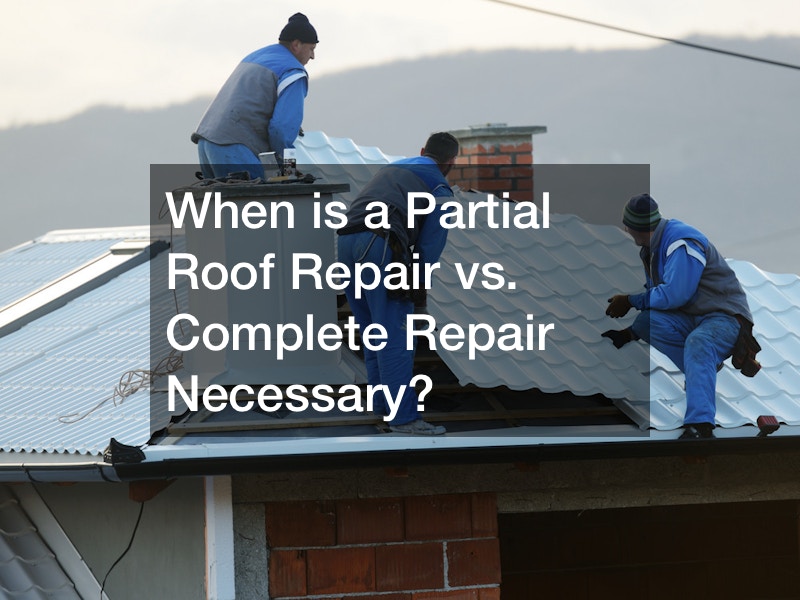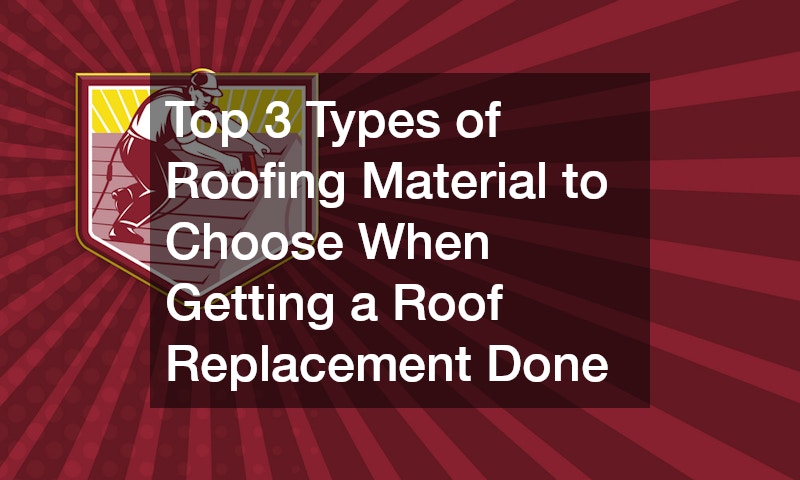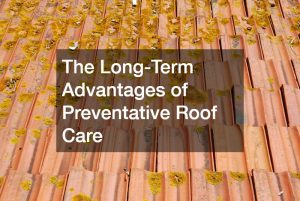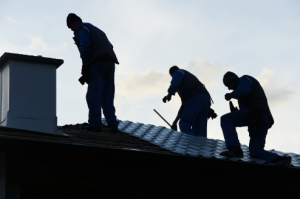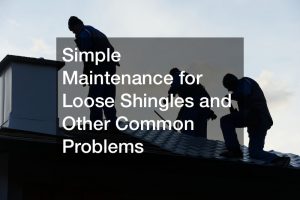When is a Partial Roof Repair vs. Complete Repair Necessary?
Any time you’re faced with roof damage, you’ll find yourself in a dilemma: should you opt for a partial roof repair or go for a complete repair? This decision holds significant importance and requires careful evaluation of various factors to ensure the most suitable solution. In this post, we’ll discuss some factors to consider when deciding between the two options.
Extent of Damage
To determine the type of damage to your roof, you can start by conducting a visual inspection yourself. Look for signs of isolated damage, such as missing or damaged shingles in specific areas or localized leaks. However, it’s highly recommended to engage a professional roofer for a comprehensive assessment. They have the expertise to identify both isolated damage and interconnected issues. Interconnected issues may indicate underlying problems affecting multiple areas of the roof, such as structural damage or systemic issues with the roofing system.
Assessing the severity of roof damage requires a careful evaluation of several factors. A roofer will consider the damage’s size, extent, and depth. They will inspect for signs of major leaks, widespread deterioration, or structural sagging. Severity can also be determined by evaluating the impact of the damage on the overall functionality and integrity of the roof.
Determining whether a partial roof repair or a complete repair is necessary depends on several factors. A roofer’s assessment takes into account the extent of the damage, the age of the roof, and its overall condition. If the damage is isolated to a specific area, such as a localized leak or a few missing shingles, a partial repair may be sufficient. However, if the damage is widespread, affects the structural integrity, or the roof is approaching the end of its lifespan, a complete repair or replacement might be the more appropriate option.
Roof Age

Determining whether a partial roof repair or a complete repair is necessary depends on the specific age-related issues identified. As the roof ages, the likelihood of multiple problems arising increases. For example, if your roof is nearing the end of its lifespan and exhibits widespread damage or structural issues, a complete repair or replacement may be the best solution to ensure long-term functionality. Conversely, if the roof is relatively young and the damage is isolated to a specific area, a partial repair might suffice.
Understanding the current age and expected lifespan of the roofing material is essential. Different roofing materials have varying lifespans, such as asphalt shingles typically lasting around 20-30 years, while metal roofs can last 40-70 years. Evaluating the age of your roof in relation to its expected lifespan provides insight into its overall durability and potential for wear and tear.
Age is an important factor in determining the necessary repairs or potential replacement for your roof for several reasons. As roofs age, they become more susceptible to issues such as leaks, shingle deterioration, or structural problems. The impact of weather exposure over time can accelerate the aging process. A local roofer can identify any underlying problems, evaluate the structural integrity, and recommend the most appropriate course of action based on their expertise and knowledge of local conditions.
Cost-effectiveness

When deciding between a partial roof repair and a complete repair, the cost of the repair or replacement will guide you. Analyzing the cost involves engaging a reputable roofing company that can provide detailed cost estimates based on the extent of the damage, required materials, and labor involved. A professional roofing company will offer certainty in assessing the cost of the repair or replacement, helping you make an informed decision based on their budget and cost considerations.
Considering potential savings on future maintenance and repairs is an important factor in determining the cost-effectiveness of the repair options. A partial repair may address immediate issues but could potentially lead to recurring repairs in the future. In contrast, a complete repair or replacement, although initially more expensive, can provide long-term savings by reducing the need for frequent maintenance and costly repairs over time.
Also, make sure to assess your budget and determine what it can comfortably afford. The cost of roof repair can vary depending on the extent of damage and the specific repair needs, ranging from around $150 to $1,500 per repair. On the other hand, the cost of a complete roof repair or replacement can range from $1,500 to $7,000 or more, depending on factors such as roof size, materials used, and labor involved.
Future Maintenance

Wondering whether to do a partial roof repair or a complete repair? Consider the potential for recurring issues. Assess whether a partial repair will adequately address the existing problems or if there is a likelihood of additional issues arising in the future. A complete repair offers the advantage of addressing underlying issues, reducing the risk of recurring problems and the need for frequent maintenance and repairs. By addressing the root causes, a complete repair provides a more robust and lasting solution, ensuring the long-term stability and performance of your roof.
The long-term durability of the repairs is another factor in the decision-making process. Consider how each repair option will withstand the test of time. A complete repair or replacement typically offers superior durability, especially when compared to temporary fixes associated with partial repairs. Investing in a comprehensive repair ensures that your roof can withstand various weather conditions and potential stressors, reducing the likelihood of future damage and the need for frequent repairs.
Also, evaluate the compatibility of each repair option with future roofing technologies. Advancements in roofing materials and technologies can enhance the performance, energy efficiency, and longevity of your roof. A complete repair or replacement allows for the integration of modern roofing technologies, such as improved insulation, solar panels, or smart roofing systems. Consulting with a local roofing company will provide valuable insights into the latest advancements and their compatibility with your roof.
Safety and Functionality

To make the best decision between a partial roof repair and a complete repair, safety, and functionality are paramount considerations. To evaluate the safety, assess the overall condition of the roof and determine if the damage poses a risk to occupants or property. Extensive damage or structural issues may compromise the safety of the roof and necessitate a complete repair to ensure a secure and stable structure. In terms of functionality, evaluate how well each repair option will restore the roof’s performance.
Consider whether a partial repair will adequately address functional issues, such as leaks or ventilation problems, or if a complete repair is needed to ensure optimal functionality. Work with a competent roofing service that will conduct a thorough assessment and obtain expert advice on safety and functionality. Their expertise and knowledge will help you make an informed decision based on the specific condition of your roof, ensuring that it is both safe and functional for years to come.
Overall Roof Condition
The overall condition of a roof is a critical aspect to consider when evaluating its health and determining whether to undertake a partial repair or a complete repair. One significant thing is to look for the presence of visible damage or deterioration. Hire a local roofing contractor to inspect the roof for cracked or missing shingles, curling edges, or sagging areas to identify potential underlying problems. Indicators such as water stains or moisture damage on the ceiling or walls inside the property also suggest underlying roofing issues.
The structural integrity of the roof is another advisable consideration. Assess the decking and supporting elements for signs of sagging, rot, or compromised structural integrity. The age of the roof also plays a significant role in evaluating its condition. Older roofs are more susceptible to wear and damage, and understanding their age provides insight into their potential longevity and repair needs. Different roofing materials have varying lifespans, so considering age is key for proper maintenance planning.
Aesthetics
Aesthetically, a partial roof repair may result in a mismatched or inconsistent look, especially if the existing roofing material is no longer available or discontinued. This can disrupt the visual cohesion of the roof and detract from the overall appearance of the property. In contrast, a complete repair ensures a uniform and visually pleasing roof, contributing to the overall curb appeal and attractiveness of the property.
Consider the neighborhood standards and architectural style prevalent in your area. Maintaining a roof that is in line with the aesthetic character of the neighborhood ensures visual harmony and prevents the property from standing out in an unappealing way. A professional roof damage repair service may provide guidance on the available options and help you make an informed decision.
Personal preference also comes into play. Your own taste and vision for the appearance of the roof may influence your decision. If you have a particular roofing style or material in mind that aligns with your aesthetic preferences, a complete repair may be necessary to achieve the desired look. The long-term satisfaction of having a visually pleasing roof should also be taken into account. Investing in a complete repair that enhances the aesthetics of the roof can bring a sense of pride and satisfaction, as it creates an inviting and visually appealing environment.
Type of Roofing Material
Different types of roofing materials have varying characteristics that can influence the decision between partial roof repair and complete repair. Asphalt shingles are a popular choice for residential roofs due to their affordability and durability. They can be repaired both partially and completely, depending on the extent of the damage. Partial repairs, such as replacing individual damaged shingles, are often sufficient for localized issues.
Metal roofs are known for their longevity and low maintenance requirements. They are often repaired through partial replacements, such as replacing damaged metal panels or repairing specific sections. Tile roofs, on the other hand, are renowned for their aesthetics and durability. Partial repairs, such as replacing cracked or broken tiles, can be done effectively to address localized issues. However, a complete repair may be required if there are widespread problems or if the roof is aging and experiencing multiple issues.
A louvered roof pergola offers adjustable shading and ventilation. Repairs for a louvered roof pergola can involve both partial and complete repair methods, depending on the specific issue. Partial repairs may include fixing individual louvers or replacing damaged components, while complete repairs may involve refurbishing the entire system or replacing it if necessary.
Weather Conditions
Different weather conditions can have varying effects on roofs, influencing the decision between partial roof repair and complete repair. In rainy or wet climates, a complete repair that focuses on enhancing overall waterproofing measures, such as replacing the entire roof membrane or improving flashing installation, may be necessary for long-term protection against water infiltration. A complete repair that reinforces the roof structure is also needed in windy or storm-prone climates.
Intense sunlight and high temperatures can accelerate the aging process of roofing materials. Partial roof repairs, such as replacing damaged shingles or tiles, can address localized issues. In hot and sunny climates, a complete repair may not be necessary unless there is widespread damage or significant deterioration. However, considering measures like installing reflective coatings or upgrading to heat-resistant materials can help improve the roof’s performance and longevity.
Insurance Coverage
The coverage limits outlined in your insurance policy dictate whether you’ll do a complete or partial roof repair. These limits set the maximum amount that the insurance company will pay for roof repairs. If the damage exceeds the coverage limit, homeowners may have to bear the additional costs themselves. In such situations, opting for a partial repair becomes the more practical choice, as it allows for addressing specific areas of damage within the coverage limit.
Another important factor to consider is the deductible specified in the insurance policy. Homeowners are typically required to pay a deductible before the insurance coverage kicks in. If the complete roof repair cost surpasses the deductible, it may be more advantageous to proceed with a complete repair. This approach maximizes insurance coverage and minimizes out-of-pocket expenses for the homeowner.
Insurance companies often evaluate the overall condition of the roof when assessing coverage eligibility. Factors such as the roof’s age, pre-existing damage, and maintenance history are taken into account. In cases where the roof has pre-existing issues, the insurance coverage may only extend to partial repairs rather than a complete replacement.
The decision between a partial roof repair and a complete repair depends on various factors that must be carefully evaluated. You should seek the expertise of professionals to assess these factors and provide tailored advice based on their specific circumstances. Considering these factors comprehensively will help you ensure the safety, functionality, and longevity of your roof while making cost-effective decisions that align with your budget and long-term goals.

